| |
 |
| |










|
  |
|
Padahastasana
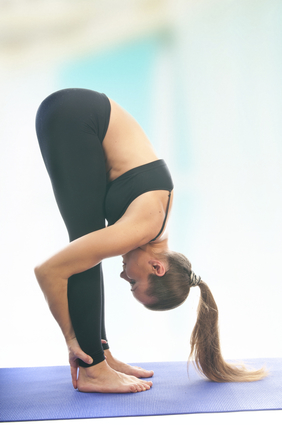
Jackknife Pose
"Nothing on earth can hold me!"
Paa-da-has-taa-sa-na Pada = foot; Hasta =
hand
Instructions
From tadasana, inhale and circle your hands
out to the sides and overhead, stretching tall. As you
exhale, push your sitbones back behind you and bend forward
from your hips, keeping your spine straight and circling your
hands out to the sides and down to wherever they reach on your
legs. Bend your knees if necessary (never lock them). Inhale
and reach with your sitbones toward the ceiling/ then exhale
and release the backs of your legs as you lengthen your
spine.
Continue breathing and relaxing, bending
forward only as far as you can keep a straight spine. Lengthen
the crown of your head away from the tailbone. Grasp the backs
of your knees, calves or ankles (whichever you can
reach); if you can do so without round-ing your spine,
wrap the first two fingers of each hand around the
inside of the corresponding big toe.
When you reach your deepest forward bend,
inhale and lengthen your spine one last time, then exhale and
release into the "surrender" phase of the pose, allowing your
spine especially the base of the spine to relax and lengthen,
and the crown of your head to release toward the
floor.
Breathe smoothly and naturally as you hold the
pose and affirm mentally, "Nothing on earth can hold
me!" Go farther into the forward bend only through relaxation,
not through effort.
To exit, release your hands and bend your
knees slightly. Then on an inhalation, push your feet into the
floor. engage your abdominal and lower back muscles, and
circle your
hands out to the sides and up as you bring
your torso back to vertical. Finish the inhalation by
stretching tall through your fingertips, then exhale into
tadasana.
Pause to integrate the effects of the
pose.
Janushirasana
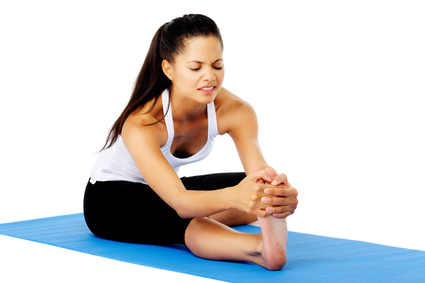
Head-to-the-Knee
Pose
"Left and right and all
around—life's harmonies are mine."
Jaa-nu-shir-aa-sa-na Janu = knee;
Sirsha = head
Instructions
From dandasana, bend your right knee and slide
your right heel into the groin area. Then rotate from the
right hip to release the knee to the floor on the right. Bring
the sole of your right foot to the inside of your left thigh.
Sit squarely on both sitbones.
Inhale and bring your hands up the front of
your body, stretching tall from your sacrum up overhead
through your fingertips. On the exhalation, bend forward from
your hips and extend your torso out over your left leg. Keep
your spine straight and bring your hands down to rest on your
left leg or foot or the floor, wherever they reach easily.
Your sternum (breastbone) should be directly over your left
leg.
Continue in this position, inhaling and
lengthening, exhaling and deepening the forward bend. Keep
your spine straight and the back of your neck long. Reach the
crown of your head away from the tailbone, and your navel
toward your left thigh. Keep your shoulders relaxed down away
from your ears and level with each other. After a number of
breaths, inhale and lengthen one last time, then exhale and
release completely into the "surrender" phase of the pose,
allowing your entire upper body to relax.
Breathe smoothly and naturally as you hold the
pose and affirm mentally, "Left and right and all around
life's harmonies are mine." Go farther into the forward bend
only through relaxation, not through effort.
To exit, on an inhalation, use your abdominal
and lower back muscles (and arms, if necessary) to recapture
the spine's natural curves, then lift your hands until they
are straight overhead, drawing your torso to vertical. Exhale
and circle your hands down to your sides. Bend your left knee,
then rotate your left hip out to the side and come into a
comfortable cross-legged sitting position.
Pause to integrate the effects of the pose,
then repeat to the other side.
Adho Mukha Shvanasana
Downward-Facing Dog
Pose
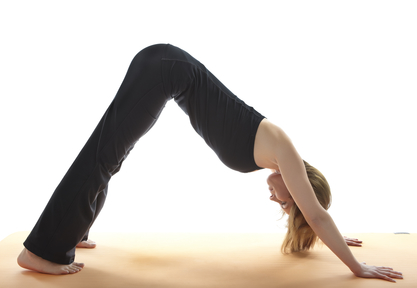
"Calmness radiates from even/fiber of my
being."
A-dho Mu-kha Shvaan-aa-sa-na Adho = down, downward; mukha =
face, facing;
shvana = dog
Instructions
Come onto your hands and knees, with your hands directly
beneath your shoulders, and your knees directly beneath your
hips. Curl your toes under and on an exhalation, push down
through your legs, and down and back through your arms. Lift
through your sitbones and straighten your knees as much as
possible while preserving the natural curves of your spine.
Bring your arms into alignment with your torso, biceps
alongside your ears. Your body now forms an inverted "V"
(unless your knees are still bent).
Keep your neck long and in line with the rest of your
spine, shoulders away from ears. Press your palms and the base
of each finger firmly into the floor. Relax your heels toward
the floor. Keep your shoulders and upper back broad.
Breathe smoothly and naturally as you hold the pose,
continually lengthening your spine and lifting your sitbones.
Mentally affirm, "Calmness radiates from every fiber of my
being."
To exit, inhale and lengthen your spine, then exhale and
bend your knees, releasing back onto hands and knees. (If you
need to rest, come down into balasana.)
Pause to integrate the effects of the pose.
Balasana
Child Pose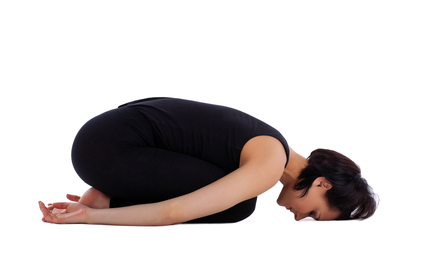
"I relax from outer involvement into my inner
haven of peace."
Baa-laa-sa-na
Bala = child
Instructions
From vajrasana, release your
hands to your sides and inhale, lengthening your spine, On the
exhalation, bend forward from the hips, leading with chest and
chin while keeping your spine straight. Come all the way down,
forehead to the floor, arms on the floor alongside your body,
palms facing up.
Relax your body completely,
and feel the breath opening your back and shoulders. Breathe
smoothly and naturally as you hold the pose. Mentally affirm,
"I relax from outer involvement into my inner haven of
peace."
To exit, inhale and bring your torso slowly upright once
again, into vajrasana.
Paschimotanasana
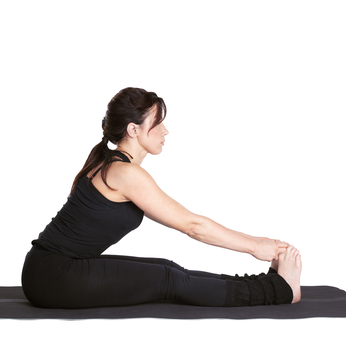
Posterior Stretching
Pose
"I am safe, I am sound. All good things come
to me; they give me peace!"
Pas-chi-mo-taa-naa-sa-na Paschima = west, or the back side
of the body; tan = to stretch/ extend
Instructions
From dandasana, inhale and bring your hands up the front of
your body, stretching tall from the sacrum up overhead through
your fingertips. On the exhalation, bend forward from your
hips and extend out over your legs, keeping your spine
straight and letting your hands come down to rest on the legs,
feet or floor, wherever they reach easily.
Continue in this position, inhaling and lengthening,
exhaling and deepening the forward bend as long as you can
keep your spine straight and the back of your neck long. Reach
the crown of your head away from the tailbone, and your navel
toward your thighs. Keep your shoulders relaxed down away from
your ears. After a number of breaths, inhale and lengthen one
last time, then exhale and release completely into the
"surrender" phase of the pose, allowing your spine to
relax.
Breathe smoothly and naturally as you hold the pose and
affirm mentally, "I am safe, I am sound. All good things come
to me; they give me peace!" Go farther into the forward bend
only through relaxation, not through effort.
To exit, on an inhalation, use your abdominal and lower
back muscles (and arms, if necessary) to recapture the spine's
natural curves, then lift your hands until they are straight
overhead, drawing your torso to vertical. Exhale and circle
your hands down to your sides, returning to dandasana for just
a moment before lying back into savasana.
Pause to integrate the effects of the
pose. | |
|  |
|